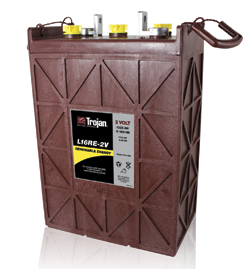Solar batteries are often called the “heart of your solar power system”.
After consulting some medical textbooks we’ve discovered that the heart is actually a very important part of the human body. Coincidence?
Actually, no. It turns out that if you’re going off-grid or grid-tied with backup, the solar battery is indeed going to be one of the fundamental pieces of your solar power puzzle.
Why?
Because whenever the sun isn’t shining (aka “nighttime”) or whenever you’re drawing more power than your system is producing (aka “laundry day”), you’re going to be drawing power from your battery bank.
Do You Need Solar Batteries?
The first thing you’ll have to decide is whether your solar power system needs batteries at all. If you’re off-grid or you want back up power in case of grid failure, your answer will be “yes”.
If you’re grid-tied and don’t worry much about occasional downtime, your answer will probably be “no”.
Batteries can be expensive and may require maintenance so many people with grid-tied systems prefer to let the grid act as their battery bank. They produce power in the day and store it in the grid and draw back power from the grid at night.
If you’ve decided to include batteries as part of your solar system, the first thing you’ll want to understand is:
Deep Cycle Batteries

For your solar power system you will need deep cycle batteries. These are designed with thicker plates for constant deep discharging and recharging. This is different than a car battery which is designed to provide a high burst of power for a short time.
Also, many batteries labeled as rv/marine deep cycle are really just modified starting batteries and not truly deep cycle. A battery that is rated in cranking amps is not deep cycle. Golf cart and forklift batteries are deep cycle and have been designed for deep discharge and recharge.
Once you’ve grasped deep cycle solar batteries, the next question you’ll have to answer is: Wet Cell or Sealed?
Wet Cell (or “Flooded”) batteries require you to be a little more “hands on” with your battery care. This is because these batteries require occasional watering and equalization.
The electrolyte level in wet cell batteries needs to be checked every few months. You will also have to check your batteries regularly to ensure they are getting charged and use a hydrometer to check the specific gravity of the electrolyte. And don’t forget to keep the top and the terminals clean.
Also, flooded batteries require venting so that accumulated gasses can be vented to the outside. Sound like a pain? Maybe, but the upside is that you’ll usually pay a lot less for a flooded solar battery.
Sealed batteries are “maintenance-free” and they come in two main varieties: “AGM” or “Gel Cell”. AGM stands for Absorbed Glass Mat and these batteries have become far more popular than the Gel Cell variety. The popularity of AGM batteries is due to the following:
- They are completely sealed so no spilling occurs
- They do not need periodic watering and emit no corrosive fumes
- The electrolyte will not stratify and no equalization charging is required
- They are well suited to systems that get infrequent use
- They can also be transported easily and safely by air
- They can be mounted on their side or end and are extremely vibration resistant
Gel cell solar batteries share many of these benefits but they are falling by the wayside due to their longer charging time and the falling cost of AGM batteries.
After deciding what kind of battery is best for you, you’ll probably be wondering…
How Many Deep Cycle Batteries Do I Need?
The amp-hour (A-Hr) rating of a battery tells you its storage capacity. This rating can be listed for different discharge time periods but the 20 hour discharge time (C20) will be closest to the typical daily cycling of a residential solar system (20 hour discharge after a 4 hour charging period).
To work out your required storage capacity, take your average daily usage and divide by the battery voltage. Let’s say you use 3600 Watts of electricity per day and your solar system operates at 12 volts.
3600 Watts divided by 12 volts = 300 amp hours
Since you don’t want battery discharge of much more than 50% you would double the 300 amp hour figure and see that you will need 600 amp hours of battery storage.
If you wanted to be ready for 3 days of cloudy weather you would multiply that 600 amp hours by 3 to get 1800 amp hours.
If you want to know how many watts a solar battery can supply, just multiply the voltage by the amp hours. E.g. A 12 volt battery that can supply 100 amp hours would provide (12 x 100)= 1200 watts.
What Kind of Battery Should I Go With?
Your choice of solar batteries breaks down into these six groups:
- Golf Cart Batteries – These are relatively cheap but will only last 2-6 years
- Regular Deep Cycle Batteries – Reasonably priced and will last 4-8 years
- Premium or “Heavy-Duty” Deep Cycle Batteries – The extra dollars will get you a lifespan of 7-15 years
- Sealed Gel Cell Batteries – Cheaper than AGM batteries but will only last 2-5 years
- Sealed AGM Batteries – Will last 4-7 years with little maintenance
- Industrial Batteries (e.g. forklift) – These workhorses can last 10-20 years
To find out which battery is right for you, you’ll have to decide if you want to go “maintenance-free” and also how much money you want to spend up front. Just remember: saving a few bucks today could mean replacing your batteries years sooner.
Think long-term.
After all, solar batteries are the heart of your solar power system.
